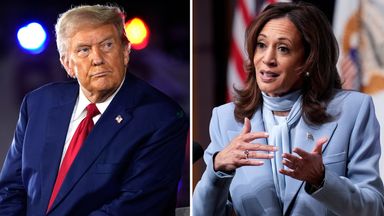US election: What if there’s a tie?
With an even number of electoral college votes in the US election, there is always a chance it could end in a draw between Donald Trump and Kamala Harris. But what is the protocol for a tie, and has it ever happened before?

It will be an intense election day tomorrow, with a few hundred thousand voters in a handful of unpredictable swing states expected to play a major role.
Donald Trump and Kamala Harris will battle it out to get the 270 Electoral College votes needed to win the election.
But if they get 269 votes each out of the 538 up for grabs, it will result in an astonishing tie between the Republican and Democratic candidates.
So what happens then?
Before we get to that, there are a couple of things you need to know about the voting system.
Americans don’t actually vote directly for who they want to be president and vice president.
Instead, they vote for “electors” – members of an Electoral College – who back their choice of candidate for those roles.
There are 50 US states, and each one has a different number of electors depending on its population.
California, for example, which has a population of nearly 40 million, has 54 electors in the Electoral College system – while North Dakota, home to about 762,000 people, has just three.
The total number of electors which make up the Electoral College is 538, which is why more than half of that number – 270 – wins you the election.
What happens if there’s a tie?
If it’s an even split, the decision for the next president and vice president is taken out of the public’s hands.
Technically, it’s also possible for votes to be split between three or more candidates to the point where no one gets a majority – but it’s incredibly rare that any candidate outside of the top two parties is competitive in elections.
If no one gets the 270 votes needed, the president would be chosen by the House of Representatives in what’s known as a contingent election.
The House of Representatives, which is the lower chamber of the US Congress, consists of 435 representatives, also known as congressmen and congresswomen, across all 50 states.
But in a contingent election, each state’s group of representatives get one collective vote, meaning the total vote is out of 50.
Whichever candidate gets 26 votes or more then becomes the president.
Unlike in a public vote, where the president and vice president are decided together, the vice president is chosen through a separate vote by the Senate, which consists of 100 senators.
It means that, in theory, a contingent election could lead to a president and vice president from opposite sides of the political spectrum taking office.
When would a contingent election take place?
It wouldn’t be until early January – and here’s why:
Even though the election result is normally announced in November once public votes are counted, it’s not actually official until electoral votes are cast and counted.
The electors cast the votes on 17 December and then those votes are counted in Congress on 6 January, which is when a president and vice president-elect are formally chosen.
In a tie scenario, though, this is when the contingent election is automatically scheduled to take place, so that a president and vice-president are selected ahead of inauguration day on 20 January.
Could there be another tie in the contingent election?
An even number of states means that, yes, there could in theory be yet another tie.
If there is a tie in the House of Representatives for a president, voting is repeated until one candidate gets the majority. But if there isn’t a winner by inauguration day then the vice president-elect voted in by the Senate would take office.
There could also be a tie in the vice-president vote, of course, which would mean the House speaker would act as president from inauguration day until a president or vice president is agreed on.
Next in line would be the president pro tempore of the Senate, or a cabinet officer.
Would there be a favourite?
Potentially, because each state is only worth one vote, regardless of size.
Therefore if one party has more state representatives than another, that party would be more likely to get the 26 votes needed in a contingent election.
It isn’t yet known which party – or if any party – will have control of a majority of states, because the November election is also for Congress, and it’s the newly-elected Congress members who would vote in the contingent election.
Read more:
US election poll tracker: Who is favourite to win?
Your ultimate guide to the US election
If a contingent election was held now, Republicans would have the edge in the presidential vote because they have 220 congressmen and women to the Democrats’ 211, and control 26 state delegations, while the democrats would have the edge in the vice president vote because they have 51 senators to the Republicans’ 49.
Has there ever been a tie?
It happened in America’s fourth election in 1800, in an outcome so problematic that it forced the nation to change its rules.
Back then, no one ran for vice president; the candidate who received the most votes became president and the runner up became vice president.
And electors got two votes each.
Electoral votes were counted and Thomas Jefferson and Aaron Burr, who belonged to the same Democratic-Republicans party, were tied with the most votes.
Like the public, Congress couldn’t decide who it wanted for the presidency, and so it took a whopping 36 votes for Jefferson to finally win.
Be the first to get Breaking News
Install the Sky News app for free


By the next election, Congress had introduced the 12th Amendment, which instructed electors to cast one vote for president and a second for vice president.
It made a contingent election less likely – but it still happened again in 1825 after four candidates split the electoral vote. Andrew Jackson got by far the most votes, but not the majority needed.
Controversially, his rival John Quincy Adams was voted the next president by Congress, despite the fact he had fewer public votes.


